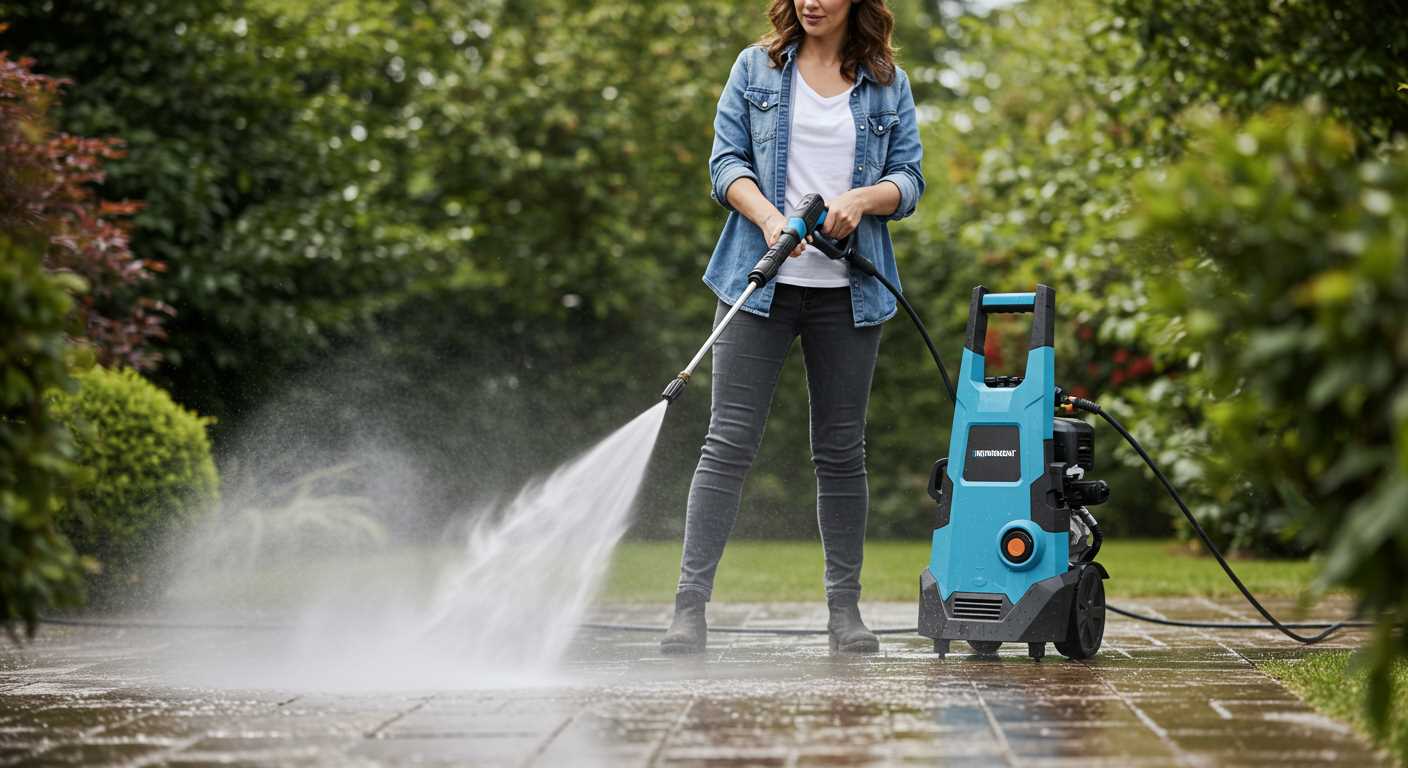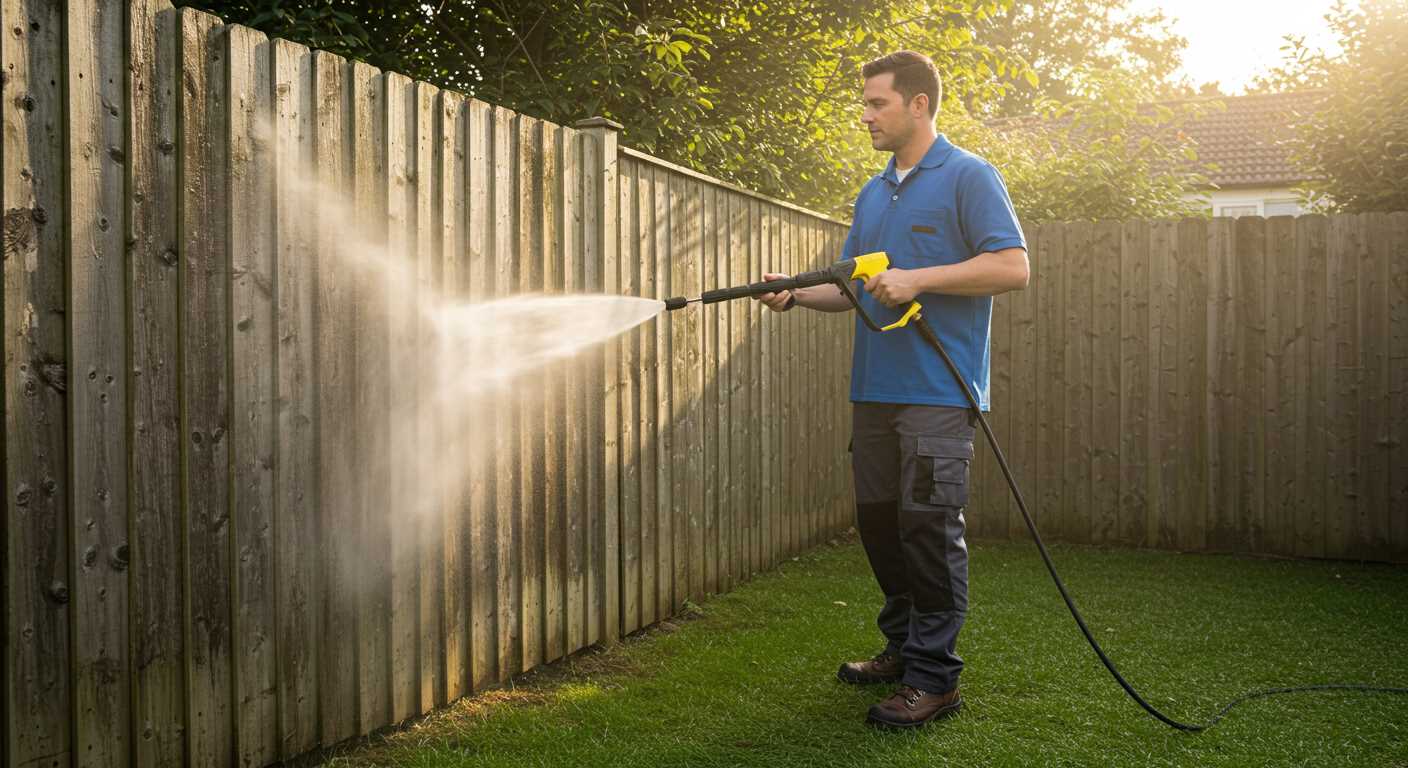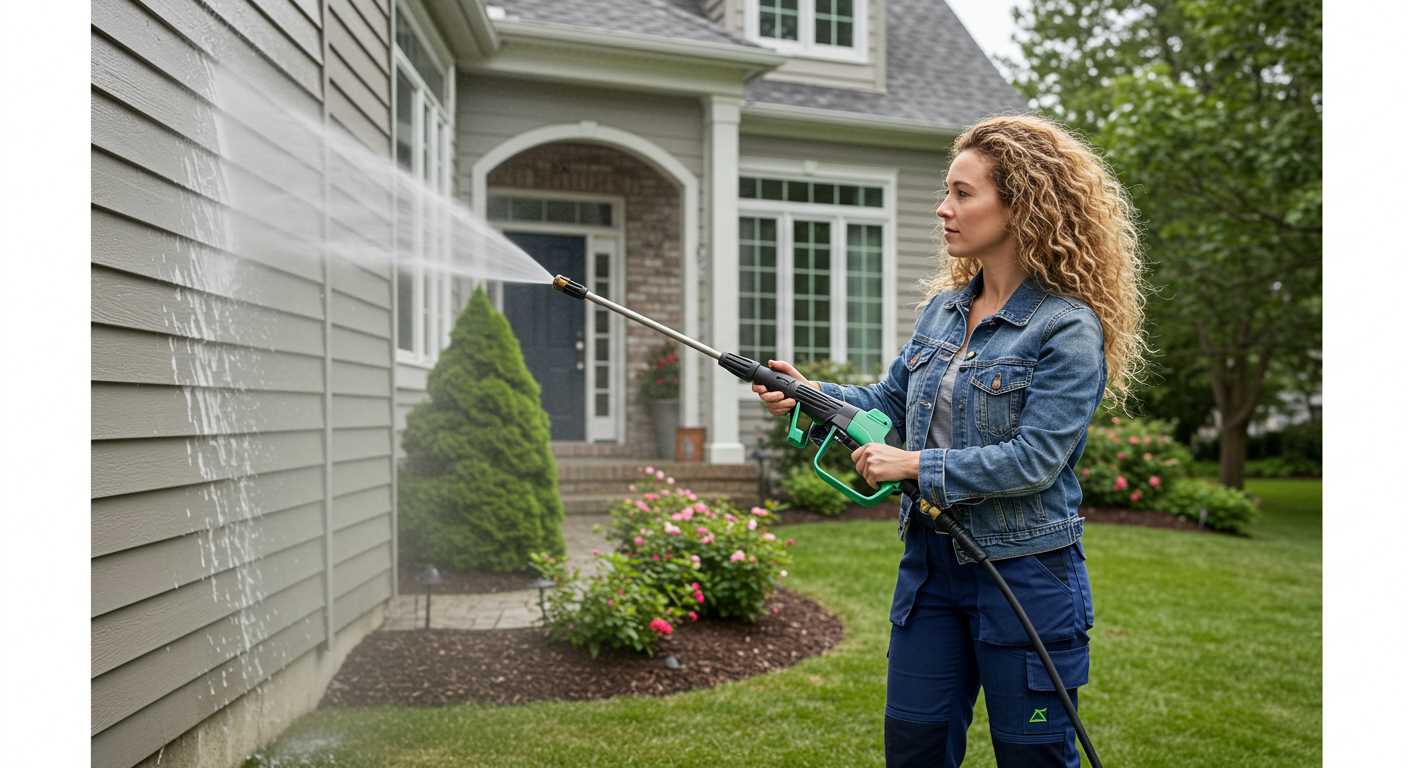

When using high-intensity cleaning devices, adhering to safety protocols is paramount. The concentrated stream can cause serious damage to skin and eyes, potentially leading to lacerations or irritation. Therefore, always wear appropriate personal protective equipment such as gloves, goggles, and sturdy footwear.
Before operating, it’s crucial to understand the distance and angle from which the water will be directed. Aim to maintain a safe distance–generally at least two feet away from surfaces–unless you are trained to handle closer encounters. Adjusting the nozzle to a wider spray pattern can also help distribute pressure and reduce risk.
Moreover, awareness of surrounding areas is essential. Keep pets and vulnerable individuals at a safe distance to prevent inadvertent harm. Familiarising yourself with the specific model is necessary, as different devices have varying pressure settings and capabilities. Perform a test spray on a small, inconspicuous area to gauge the impact before tackling larger projects.
Impacts of High-Pressure Cleaning Equipment

High-pressure cleaning tools can cause damage if not used correctly. For skin, the concentrated jets can penetrate deeply, leading to cuts and abrasions. It’s crucial to maintain a safe distance, typically at least two feet away from surfaces and your body.
When selecting a model, examine the specifications for pressure output. A unit exceeding 2500 PSI poses a higher risk of injury. Always wear protective gear, including gloves and goggles, to shield from potential accidents or debris.
Always avoid directing the spray towards people or animals. Besides physical harm, operating these devices without proper training can lead to accidents. Investing time in understanding the equipment can mitigate risks significantly.
In case of accidental contact, seek medical attention for any wounds. Some injuries may appear minor but can escalate if not treated promptly. Overall, responsible usage and respect for the power of these machines are paramount for safety.
Understanding Safety Features of Cleaning Equipment
Always check for automatic shut-off systems. These mechanisms terminate operation when the trigger isn’t engaged, significantly reducing risks associated with unintended activation. I’ve seen many injuries occur simply because the equipment was left running while unattended.
Look for models equipped with safety locks on the trigger. This feature prevents accidental engagement, especially when the device is being moved or stored. It’s a small but effective addition that can save you from unfortunate incidents.
Adjustable pressure settings are invaluable. Being able to lower the intensity can protect surfaces and limbs alike. I recommend familiarising yourself with these settings before use to ensure you’re operating within safe parameters for each task.
Another feature to consider is the inclusion of durable hoses with reinforced edges. This reduces the chance of ruptures or leaks, which can lead to hazardous situations. Inspect hoses regularly for any signs of wear and replace them if necessary.
Be aware of the ergonomic design of the handle and trigger. A comfortable grip reduces the risk of accidents caused by fatigue. When I’ve tested various models, the ones with user-friendly designs often result in better control and less strain during prolonged use.
Finally, ensure proper training and personal protective equipment are part of your safety protocol. Even the best features can’t replace the value of knowledge and preparation. Make it a habit to educate yourself and others on safe handling practices before engaging any cleaning apparatus. Your safety should never be compromised.
The Impact of High Pressure on Different Surfaces

Using equipment that generates high water pressure can cause significant damage to various materials if not handled correctly. For soft surfaces like wood, limits should be set to prevent gouging or splintering. It’s recommended to keep nozzle distance around 30 cm, using low pressure settings to avoid compromising integrity.
When working with painted or coated surfaces, such as cars or outdoor furniture, select a fan tip to distribute force evenly. Maintaining a distance of at least 45 cm while employing low pressure helps decrease the risk of peeling paint or removing finishes.
Concrete and brick benefit from intense force and can typically withstand high-powered streams. However, caution is still necessary. At close range, it can erode mortar joints or create pockmarks in the surface. For these, a distance of 30–60 cm is usually safe, combined with a multi-nozzle approach to ensure consistent cleaning without damaging the surface.
For delicate surfaces like vinyl siding or roofing materials, the recommended action is to utilise wider fan nozzles while maintaining a higher distance of about 60 cm. This technique mitigates the chance of deformation or leaks.
Always check the manufacturer’s recommendations for specific materials. In my experience, matching the right nozzle and technique to the surface type not only enhances cleaning results but also preserves the quality and longevity of the surfaces involved.
Common Injuries Associated with Improper Use

Using this high-powered cleaning tool without proper technique or caution can lead to several injuries. Here are the most common ones I’ve observed during my tenure in the industry:
| Injury Type | Description | Prevention Tips |
|---|---|---|
| Skin Punctures | High-pressure jets can penetrate the skin, causing cuts or more serious wounds. | Wear protective clothing, including gloves and long-sleeved shirts. |
| Eye Injuries | Debris or chemicals can be propelled at high speeds, resulting in eye damage. | Always use safety goggles to shield your eyes from potential projectiles. |
| Hearing Damage | Prolonged exposure to the noise of this equipment can lead to hearing loss. | Use ear protection, especially during extended use. |
| Respiratory Issues | Inhalation of harmful dust or fumes generated during operation may cause health problems. | Ensure proper ventilation and consider using a mask if working with chemicals. |
| Muscle Strain | Improper posture or excessive force can lead to strains in the back and arms. | Maintain correct posture and take regular breaks to avoid fatigue. |
By adhering to safety guidelines and recommendations, the risks associated with this equipment can be significantly reduced. Proper training and awareness of the dangers play a crucial role in preventing accidents.
Protective Gear Recommendations for Users
Wearing appropriate protective equipment significantly reduces the risk of accidents while handling high-powered cleaning machines. Here’s what I recommend based on years of testing various equipment.
Essential Gear

- Safety Glasses: Invest in impact-resistant eyewear to shield your eyes from debris and harmful splashes.
- Hearing Protection: Opt for earplugs or earmuffs to minimise the noise impact of the equipment over prolonged use.
- Gloves: Use thick rubber or neoprene gloves to protect your hands from water spray and potential chemicals.
- Boots: Choose waterproof, slip-resistant footwear to prevent slipping on wet surfaces and to keep your feet dry.
- Full-Body Coveralls: Wear durable, non-porous clothing that offers full coverage, helping to protect your skin from water and chemicals.
Additional Considerations
- Face Shield: For extensive cleaning tasks, a full-face shield provides extra protection against flying debris.
- Respirator: If working with detergents or cleaning agents, a mask can protect against inhaling hazardous vapours.
- Hat: A wide-brimmed hat can shield your face and neck from sun exposure if working outdoors.
Prioritising safety while using high-powered cleaning devices not only enhances your protection but also improves the efficiency of your work. Each piece of gear plays a vital role in maintaining safety standards.
How to Use a Pressure Washer Safely
Before you start, ensure you read the manufacturer’s manual thoroughly. Familiarity with your equipment is paramount.
Always conduct a pre-use inspection. Check hoses, nozzles, and connections for any damage or leaks.
Use a suitable nozzle for the task at hand. A wide-angle nozzle is safer for delicate surfaces, while narrower options should be reserved for tough grime.
Maintain a safe distance from surfaces, typically around 2 feet, to minimise the risk of damage. Gradually decrease the distance as needed, but never get too close.
Keep the spray aimed away from yourself and others. Use the locking mechanism to prevent accidental discharge when not in use.
Always wear protective gear like safety goggles, gloves, and slip-resistant footwear. Ensure that your attire is appropriate; avoid loose clothing that could get caught in machinery.
If using cleaning agents, ensure they are compatible with your equipment. Follow the manufacturer’s guidelines for diluting and applying solutions.
Educate those around you about equipment operation and safety precautions. Having a spotter can help if you are working in confined or potentially hazardous areas.
Never point the nozzle at animals or people. Explain the importance of keeping a safe distance from the work area.
After your task, clean all equipment thoroughly. Proper storage extends the lifespan of your tools and ensures they maintain optimal performance.
Testing your equipment before starting is vital; this helps in adjusting to the handling and pressure levels. Engage in practice sessions on non-delicate surfaces to gain confidence.
Lastly, remain cautious of your surroundings. Avoid working in wet conditions or on sloped surfaces, as this increases the risk of accidents.
Frequently Asked Questions About Risks Associated with High-Pressure Cleaning Devices

Always keep distance from moving parts and avoid contact with the jet, which can easily cause abrasions or puncture wounds. A safe distance is typically around 2 feet from the surface.
Believe it or not, the types of surfaces can significantly impact the effects. Wood may dent, while concrete can withstand higher force. Always test in a less visible area first.
Wearing proper gear is non-negotiable. Safety goggles, gloves, and sturdy footwear must be part of your routine to minimise potential injuries.
If you accidentally spray yourself, wash the affected area immediately with soap and water. If you experience severe pain or notice severe injuries, seek medical advice without delay.
Electric units can present electric shock risks when used in wet conditions. Maintaining a dry work area is essential to ensure safety throughout the task.
Pet owners should secure animals away from the cleaning area. The noise and pressure can startle pets and lead to unpredictable behaviours.
Fingers can become pinched or injured if caught in the trigger or moving parts. Always handle the device with care and ensure it is turned off when not in use.
Regular maintenance checks can prevent malfunction. Inspect hoses, fittings, and connections for damage each time before starting your tasks.
Keep children and bystanders at least 10 meters away during operation. It prevents accidental exposure to high-pressure streams that could cause harm.
Best Practices for Maintaining Equipment and User Safety
.jpg)
Regular inspections are key. Before each use, check hoses, nozzles, and all connections for wear or damage. Any sign of deterioration means it’s time for repairs or replacements. A single crack can lead to dangerous malfunctions.
Cleaning the machine after each session is crucial. Residue can accumulate, affecting performance and safety. Use warm, soapy water and ensure all components are free from debris.
Proper storage prevents damage. Always store in a dry place, away from extreme temperatures. Keeping the unit covered can also protect against dust and moisture.
- Ensure the water used is clean and free from contaminants to avoid clogs.
- Check oil levels regularly in gas models; low oil can lead to engine failure.
- Inspect and clean filters as part of maintenance; a clogged filter can reduce efficiency.
Utilise manufacturer guidelines for maintenance schedules. Following these recommendations fosters longevity and performance. Be conscientious about scheduled servicing for gas machines.
Using the right attachment is essential. Each nozzle serves a specific purpose and using the wrong one can lead to equipment strain or unsafe situations. Familiarise yourself with the impact of each attachment, and only use those recommended.
Training is non-negotiable. Proper instruction on operating techniques and features is vital for safe usage. Engage with manuals, and watch instructional videos to fully understand the workings of your device.
After any extended downtime, conduct tests to ensure everything is functioning properly. It’s better to identify issues before use rather than discovering them in the middle of a job.
Lastly, create a checklist for pre-use inspections and maintenance. Having a systematic approach ensures nothing is overlooked, enhancing safety and efficiency during operations.
FAQ:
Can a pressure washer cause harm to skin or eyes?
Yes, a pressure washer can indeed cause harm to both skin and eyes if proper precautions are not taken. The high-pressure jets of water can easily penetrate skin, leading to cuts or abrasions. In more severe cases, it may cause serious injuries. Eye injuries can also occur due to debris being ejected at high speeds. Always wear protective gear, including goggles and gloves, when using a pressure washer to minimise the risk of injury.
Is it safe to use a pressure washer on delicate surfaces?
Using a pressure washer on delicate surfaces requires caution. The high pressure can damage materials such as wood, certain types of glass, and painted surfaces. It is advisable to check the manufacturer’s guidelines for the materials being cleaned. If you are unsure, consider using a lower pressure setting or choosing alternative cleaning methods to avoid potential damage. Testing on a small, inconspicuous area before proceeding is recommended.
What safety measures should I take while using a pressure washer?
To ensure safety while using a pressure washer, follow several key measures. First, always wear eye protection to guard against flying debris and protective gloves to prevent skin injuries. Check hoses and nozzles for leaks or wear before use. Keep the nozzle pointed away from your body and avoid using it on surfaces that are at risk of damage. Never point the pressure washer at people or animals. It is also wise to have a first aid kit on hand in case of accidents.







